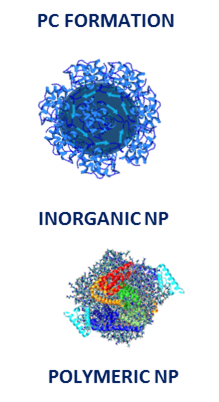The protein corona signature depending on the type of nanocarrier, indicates its diversity and complexity and makes it difficult to predict its final action. By defining individual proteins’ roles, it is possible to identify specific proteins responsible for nanocarriers’ biological pathways. So far, it has been assumed that predominantly quantitative proteins or proteins with dedicated biological functions have a significant impact on the molecular target’s achievement. Understanding which proteins found in the protein corona define the nanoparticle pathway is critical to the targeted nanocarriers’ appropriate design.
Understanding the mechanism of protein corona (PC) formation in different nanosystems is therefore fundamental to control this phenomenon with an appropriate strategy. The proteins that makeup PC can be classified as opsonins and dysopsonins. The former group promotes the rapid removal of NP from the blood, while the latter prolongs NP’s circulation.
This project investigates how different types of nanoparticles and how to functionalize the carrier surface can extend the half-life of NPs through a selective affinity for dysopsonin proteins. Mesoporous silica nanoparticles (MSNs) and dendrimers will be used as model nanosystems. Nanoparticles coated with disopsonins are expected to block opsonins’ adsorption, thus increasing the mean lifetime of NPs in biological fluids. Both experimental and computational methods will be used to elucidate the mechanism regulating the formation of the protein corona (PC) on model NPs with well-defined physicochemical properties. This approach will enable the design of adequately functionalized NPs with improved half-lives in biological fluids. Both Polish and Italian research groups are currently working on PC formation in delivery systems for dendrimer systems and mesoporous silica nanoparticles, respectively.